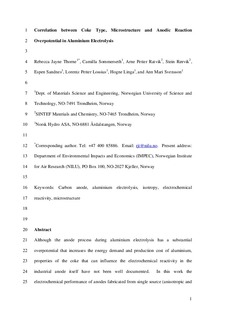Correlation between coke type, microstructure and anodic reaction overpotential in aluminium electrolysis
Thorne, Rebecca Jayne; Sommerseth, Camilla; Ratvik, Arne Petter; Rørvik, Stein; Sandnes, Espen; Lossius, Lorentz Petter; Linga, Hogne; Svensson, Ann Mari
Journal article, Peer reviewed
Submitted version
Permanent lenke
http://hdl.handle.net/11250/2463706Utgivelsesdato
2015Metadata
Vis full innførselSamlinger
- Institutt for materialteknologi [2549]
- Publikasjoner fra CRIStin - NTNU [38127]
Originalversjon
Journal of the Electrochemical Society. 2015, 162 (12), E296-E307. 10.1149/2.0461512jesSammendrag
Although the anode process during aluminum electrolysis has a substantial overpotential that increases the energy demand and production cost of aluminum, properties of the coke that can influence the electrochemical reactivity in the industrial anode itself have not been well documented. In this work the electrochemical performance of anodes fabricated from single source (anisotropic and isotropic) cokes, including an ultrapure graphite as reference material, was determined, and compared to the material properties of the cokes and baked anodes. Anodes were characterized for air and CO2 reactivity and optical texture, and cokes and anodes characterized for presence of oxygen surface groups and microstructure (fractions of basal, edge and defect sites on the surface and pore volume below 16 nm). Results show that anodes made from more isotropic cokes (increasing optical texture fineness) had a slight improvement in electrochemical performance compared to those made from more anisotropic cokes. For all anodes, electrochemical reactivity correlated with the electrochemically-wetted surface area, as determined by the double layer capacitance. This appears to be related to microstructure and possibly also to differences in surface chemistry, rather than differences in surface roughness and porosity as determined by optical techniques (i.e. on a μm-scale).
